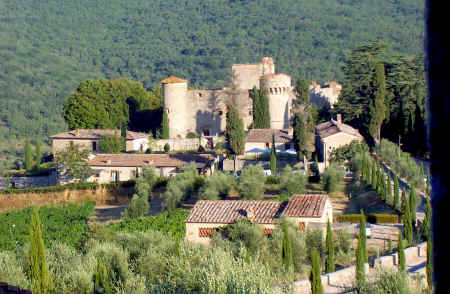|
The Castle of Meleto
is first documented as a possession of the monks of the nearby Badia
a Coltibuono in the 11 C. The first vassal of the Castello di
Meleto seems to have been a certain Guardellotto, but he was stripped of all
of his possessions as a result of a difference of opinion with the Emperor Federico Barbarossa.
The latter then entrusted Meleto to the local Firidolfi family who
were already in possession of several other castles of the area. This was
the origin the branch of the Firidolfi known as "di Meleto" while another
branch of the family, known as the Ricasoli
Fibindacci, soon became prominent in the history of this part of
Chianti, based at their castle
at Brolio.
The Castello di Meleto was strategically very important for a number of
reasons. It was very near the border between Siennese and Florentine
territory, and was, indeed, the last Florentine fortification in this
direction. It is located on a hill that dominates the important road
running between the Val
d'Arno and the Chianti
valley, and hence also became one of the principal fortifications
of the
terzieri
of the Chianti League which consisted of Gaiole,
Radda and Castellina.
Not surprisingly, for centuries the Castello di Meleto was the scene of
skirmishes and battles, in large part between the forces of Florence
and Sienna
without, however, suffering serious damage. The essentially military
purpose of the structure is readily evident even today, despite the
modifications carried out in the 18 C. The ground plan of the castle is an
irregular square, almost trapezoidal, with the keep, lower than it was
originally, situated in the middle.
In 1478 the castle was occupied by the Aragonese army allied with Sienna,
but two years later it was regained by the Florentines who initiated major
work to reinforce the defences.
The additions made during the1480's are virtually totally intact even
today. They include the two huge, cylindrical and machicolated bastion
towers located at the more exposed southern angles of the castle walls. (Machicolations
are floor openings between the supporting corbels of a battlement, through which
stones, boiling oil etc. could be dropped on attackers at the base of the wall.)
Dating from the same period, there are the two brick reinforcements at the northern angles
of the walls, overlooking the edge of the crag and so already naturally
defended to some extent. Other reinforcements were made to the curtain
walls facing the only access road, and loopholes and gun holes (now partly
disappeared) were inserted along the whole perimeter of the castle enclosure.
In 1529, thanks to these improvements, the castle of Meleto was able
successfully to withstand to a siege by the imperial troops.
Although Meleto Castle was never seriously damaged by sieges and battles,
it was considerably modified when it was transformed into a villa during the
18 C when its defenses were partly dismantled. The interior today still
reflects the style of this period, with decorated halls and a remarkable little
theatre, dating from 1742, that still possesses its seven original stage
scenes. Meleto remained the property of the Ricasoli family until about thirty years
ago. Today it is owned by a wine producing company and offers vacation
accommodation and a wonderful Tuscan
wedding venue.
|
